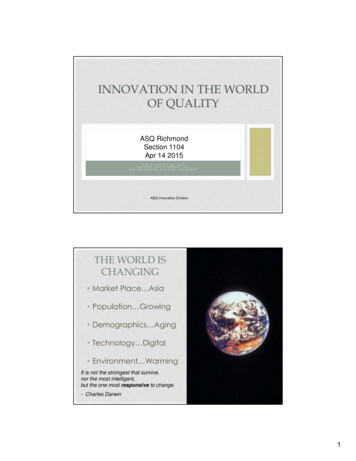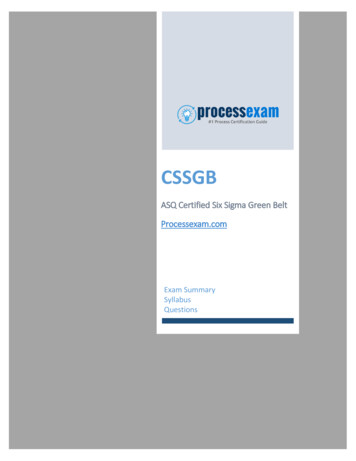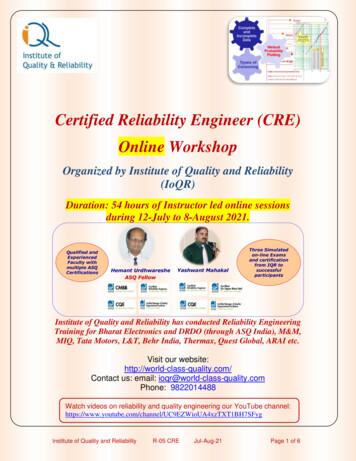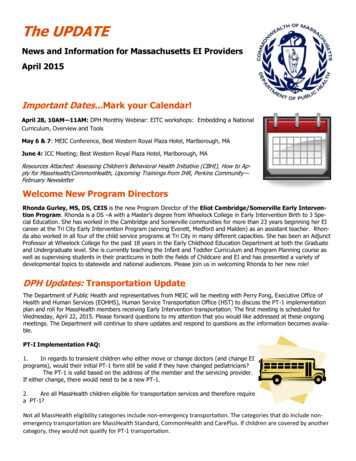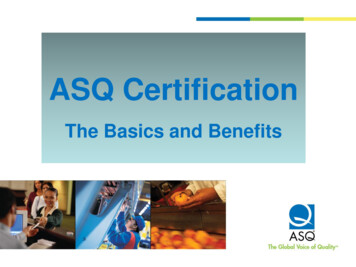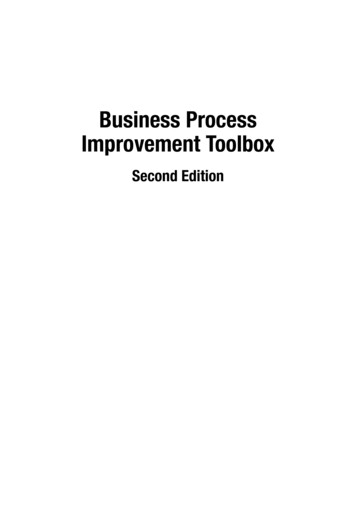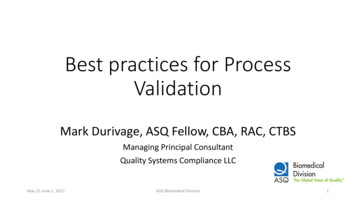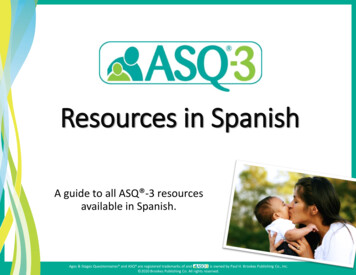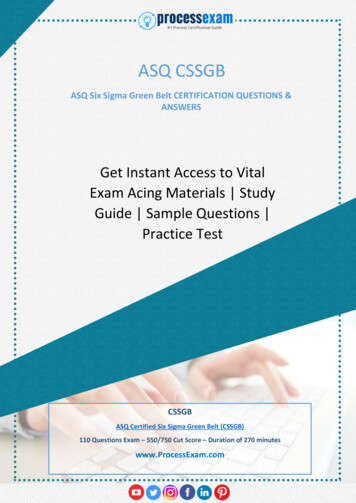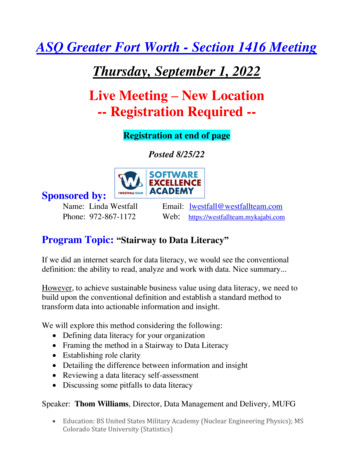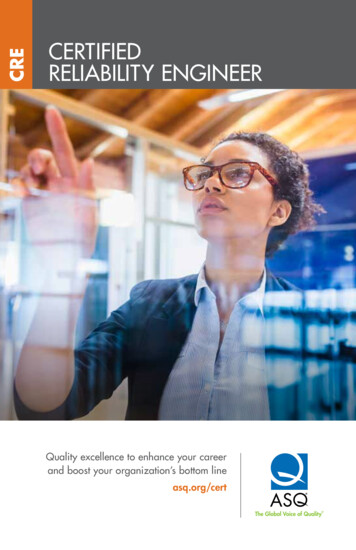
Transcription
CRECERTIFIEDRELIABILITY ENGINEERQuality excellence to enhance your careerand boost your organization’s bottom lineasq.org/cert
Certification from ASQ is considered a mark ofquality excellence in many industries. It helps youadvance your career, and boosts your organization’sbottom line through your mastery of quality skills.Becoming certified as a Reliability Engineer confirmsyour commitment to quality and the positive impactit will have on your organization.ExaminationEach certification candidateis required to pass a writtenexamination that consists ofmultiple-choice questions thatmeasure comprehension ofthe body of knowledge.2Certified Reliability Engineer
INFORMATIONCertified Reliability EngineerThe Certified Reliability Engineer (CRE) understands the principles of performanceevaluation and prediction to improve product/systems safety, reliability, andmaintainability. This body of knowledge and applied technologies include, but arenot limited to, design review and control; prediction, estimation, and apportionmentmethodology; failure mode and effects analysis; the planning, operation, andanalysis of reliability testing and field failures, including mathematical modeling;understanding human factors in reliability; and the ability to develop and administerreliability information systems for failure analysis, design, and performanceimprovement and reliability program management over the entire product life cycle.CREComputer Delivered – The CREexamination is a one-part, 165question, four-and-a-half-hour examand is offered in English only. Ofthese questions, 150 are scoredand 15 are unscored.Paper and Pencil – The CREexamination is a one-part, 150question, four-hour exam and isoffered in English only.For comprehensive exam information on the Certified Reliability Engineercertification, visit asq.org/cert.Certified Reliability Engineer3
Work ExperienceYou must have eight years of on-the-jobexperience in one or more of the areasof the Certified Reliability Engineer Bodyof Knowledge. A minimum of threeyears of this experience must be in adecision-making position. “Decisionmaking” is defined as the authority todefine, execute, or control projects/processes and to be responsible for theoutcome. This may or may not includemanagement or supervisory positions.If you are now or were previouslycertified by ASQ as a QualityEngineer, Quality Auditor, SoftwareQuality Engineer, Supplier QualityProfessional, or Manager of Quality/Organizational Excellence, experienceused to qualify for certification in thesefields often applies to certification asa Reliability Engineer.4Certified Reliability EngineerIf you have completed a degree*from a college, university, or technicalschool with accreditation acceptedby ASQ, part of the eight-yearexperience requirement will bewaived as follows (only one ofthese waivers may be claimed): D iploma from atechnical or trade school—one year waived Associate’s degree—two years waived Bachelor’s degree—four years waived Master’s or doctorate—five years waived*Degrees or diplomas fromeducational institutions outsidethe United States must beequivalent to degrees fromU.S. educational institutions.
Certified Reliability Engineer5
BODY OF KNOWLEDGECertified Reliability Engineer (CRE)Topics in this body of knowledge (BoK) include additional detail in theform of subtext explanations and the cognitive level at which the questionswill be written. This information will provide useful guidance for both theExamination Development Committee and the candidates preparing totake the exam. The subtext is not intended to limit the subject matter orbe all-inclusive of what might be covered in an exam. It is intended toclarify the type of content to be included in the exam. The descriptor inparentheses at the end of each entry refers to the highest cognitive levelat which the topic will be tested. A more comprehensive description ofcognitive levels is provided at the end of this document.I. Reliability Fundamentals(25 questions)A. Leadership Foundations1. Benefits of reliability engineeringDescribe the value that reliabilityhas on achieving company goalsand objectives, and how reliabilityengineering techniques and methodsimprove programs, processes,products, systems, and services.(Understand)2. Interrelationship of safety,quality, and reliabilityDescribe the relationship ofand distinguish between reliabilityand quality, and describe theimportance of safety in reliabilityengineering and how reliabilityimpacts safety. (Understand))3. Reliability engineerleadership responsibilitiesDescribe how to be a reliabilitychampion by influencing programdecisions and facilitating crossfunctional communication.(Understand)6Certified Reliability Engineer4. Reliability engineer roleand responsibilities in theproduct life cycleDescribe how the reliabilityengineer influences the product lifecycle, and describe a reliabilityengineer’s role in the design reviewprocess in order to anticipate howreliability can impact risk and costs,and ensure performance over time.(Understand)5. Function of reliabilityin engineeringDescribe how reliability techniquescan be used to apply best practicesin engineering (e.g., measuringreliability early), how industrystandards can impact reliability,and how reliability can inform thedecision analysis process. (Analyze)6. Ethics in reliability engineeringIdentify appropriate ethicalbehaviors for a reliability engineerin various situations. (Evaluate)7. Supplier reliability assessmentsExplain how supplier reliabilityimpacts the overall reliability programand describe key reliability conceptsthat should be included in supplierreliability assessments. (Analyze)
8. Performance monitoringDescribe the importance ofperformance monitoring toensure that product reliability orsafety requirements continue to bemet, and identify life-cycle pointsin which process and productreliability data are collectedand evaluated. (Understand)B. Reliability Foundations1. Basic reliability terminologyExplain basic terms related toreliability and the associatedmetrics (e.g., MTTF, MTBF, MTTR,service interval, maintainability,availability, failure rate, reliability,and bathtub curve). (Apply)2. Drivers of reliabilityrequirements and targetsDescribe how customerexpectations and industrystandards, safety, liability, andregulatory concerns drive reliabilityrequirements. (Understand)3. Corrective andpreventive action (CAPA)Identify corrective and preventiveactions to take in specific situationsand evaluate their measures ofeffectiveness. (Evaluate)4. Root cause analysisDescribe root cause analysis,and use a root cause and failureanalysis tool to determine thecauses of degradation or failure.(Evaluate)5. Product life-cycleengineering stagesDescribe the impact various lifecycle stages (concept/design,development/test, introduction,growth, maturity, decline) haveon reliability, and the cost issues(product maintenance, life expectation, software defect phasecontainment, etc.) associated withthose stages. (Understand)6. Economics of productmaintainability and availabilityDescribe the cost tradeoffsassociated with productmaintainability strategies andavailability. (Understand)7. Cost of poor reliabilityDescribe how poor reliabilityaffects costs over the life cycle.(Understand)8. Quality triangleDescribe the relationship between cost, time, and quality withrespect to reliability. (Understand)9. Six Sigma methodologiesDescribe how Six Sigma principlessupport reliability engineering.(Understand)10. Systems engineeringand integrationDescribe the role of reliabilityengineering within systemsengineering, including theintegration of components andtheir interfaces/interactionswithin the system. (Understand)II. Risk Management(25 questions)A. Identification1. Risk management techniquesUse risk management tools andprocesses to identify, document, andtrack concerns. Identify and prioritizesafety, economic, performance,and customer satisfaction concernsutilizing an appropriate riskmanagement framework. (Analyze)2. Types of riskIdentify the various types of risks,including technical, scheduling, safety,and financial, and describe theirrelationship to reliability. (Analyze)B. Analysis1. Fault tree analysis (FTA)Use fault tree analysis (FTA)techniques to evaluate productor process failure. (Analyze)2. Failure mode andeffects analysis (FMEA)Define and distinguish betweenfailure mode and effects analysis(FMEA) and failure mode, effects,and criticality analysis (FMECA)and apply these techniques tosystems, products, processes,and designs. (Evaluate)Certified Reliability Engineer7
3. Common mode failure analysisDescribe common mode failure(also known as common causefailure) and how it affects risk.(Understand)4. Hazard analysisDescribe how hazard analysisinforms the development process,and how information obtained asa result of the hazard analysis isused by the reliability engineer.(Understand)5. Risk matrixDescribe how risk matrices are usedin the assessment of risk in regard tolikelihood and severity. (Understand)6. System safetyIdentify safety-related issues byanalyzing customer feedback,design data, field data, andother information. Prioritize safetyconcerns, and identify steps thatwill minimize the improper use ofequipment, products or processes.(Evaluate)C. MitigationIdentify appropriate risk mitigation(treatment) plans to include controlsthat will minimize risk and subsequentimpact in terms of safety, liability, andregulatory compliance. (Evaluate)III. Probability and Statisticsfor Reliability (35 questions)A. Basic Concepts1. Basic statisticsDefine various basic statisticalterms (e.g., population, parameter,statistic, sample, central limittheorem, parametric and nonparametric), and compute andinterpret their values. (Analyze)2. Basic probability conceptsUse basic probability concepts(e.g., independence, mutuallyexclusive, conditional probability),and compute and interpret theexpected values. (Analyze)3. Probability distributionsCompare and contrast variousdistributions (e.g., binomial,8Certified Reliability EngineerPoisson, exponential, Weibull,normal, and log-normal), andrecognize their associatedprobability plots. (Analyze)4. Probability functionsCompare and contrast variousprobability functions (e.g.,cumulative distribution functions(CDFs), probability densityfunctions (PDFs), and hazardfunctions), and recognize theirapplication in various situations.(Apply)5. Sampling plans for statisticsand reliability testingUse various theories, tables, andformulas to determine appropriatesample sizes or testing time forstatistical and reliability testing.(Apply)6. Statistical process control (SPC)and process capability studies(Cp, Cpk)Define and describe SPC andprocess capability studies (Cp,Cpk, etc.), control charts, andhow each is related to reliability.(Understand)7. Confidence and tolerance intervalsCompute confidence intervalsand tolerance intervals, drawconclusions from the results, anddescribe how point estimates areused to determine the interval.(Evaluate)B. Data Management1. Sources and uses of reliability dataDescribe sources of reliabilitydata (prototype, development,test, field, warranty, published, etc.),their advantages and limitations,and how the data can be usedto measure and enhance productreliability. (Analyze)2. Types of dataIdentify and distinguish betweenvarious types of data (e.g.,attributes vs. variable, discrete vs.continuous, censored vs. complete,and univariate vs. multivariate).Select appropriate analysis toolsbased on the data type. (Evaluate)
3. Data collection methodsIdentify and select appropriatedata collection methods (e.g.,surveys, automated tests, automatedmonitoring, and reporting tools) inorder to meet various data analysisobjectives and data quality needs.(Evaluate)4. Data summary and reportingExamine collected data for accuracyand usefulness. Analyze, interpret,and summarize data for presentationusing various techniques, based ondata types, sources, and requiredoutput. (Create)5. Failure analysis methodsDescribe failure analysis toolsand methods (e.g., mechanical,materials, physical analysis, andscanning electron microscopy(SEM)) that are used to identifyfailure mechanisms. (Understand)6. Failure reporting, analysis, andcorrective action system (FRACAS)Identify elements necessary forFRACAS, and demonstrate theimportance of a closed-loopprocess. (Evaluate)IV. Reliability Planning, Testing,and Modeling (35 questions)A. Planning1. Reliability test strategiesDevelop and apply theappropriate test strategies(e.g., truncation, test-to-failure,degradation, growth plan, andtest, analyze, and fix (TAAF)) forvarious product developmentphases. (Evaluate)2. Environmental andconditions of use factorsIdentify environmental anduse factors (e.g., temperature,humidity, and vibration) andstresses (e.g., severity of service,electrostatic discharge (ESD),throughput, and duty cycle)to which a product may besubjected. (Analyze)3. Failure consequenceDescribe the importance ofidentifying the consequences offailure modes when establishingreliability acceptance criteria.(Understand)4. Failure criteriaDefine and describe failure criteriabased on system requirements andwarranty terms and conditions.(Understand)5. Test environmentAppraise the environment in termsof system location and operationalconditions, and designate theenvironment in the test plan toensure an appropriate test strategyis implemented. (Evaluate)B. TestingDescribe the purpose, advantages,and limitations of each of the followingtypes of tests, and use common modelsto develop test plans, evaluate risks,and interpret test results. (Evaluate)1. Accelerated life tests(single-stress, multiple-stress,sequential stress, step-stress, HALT,margin tests)2. Stress screening(ESS, HASS, burn-in tests)3. Qualification/Demonstration testing(sequential tests, fixed-length tests)4. Degradation(wear-to-failure) testing5. Software testing(white-box, black-box, operationalprofile, and fault-injection)C. Modeling1. Reliability blockdiagrams and modelsGenerate and analyze varioustypes of block diagrams andmodels, including series, parallel,partial redundancy, and timedependent. (Evaluate)Certified Reliability Engineer9
2. Physics of failureand failure mechanismsIdentify various potential failuremechanisms (e.g., fracture,corrosion, memory corruption)and describe the physical processof these failures. (Apply)3. Failure modelsSelect appropriate theoretical models(e.g., Arrhenius, S-N curve) to assessor predict failure rates. (Analyze)4. Reliability prediction methodsUse various reliability predictionmethods (e.g., Monte Carlosimulation, part stress analysis,and parts count prediction) forboth repairable and nonrepairablecomponents and systems, anddescribe the inputs into the model.(Apply)5. Design prototypingDescribe the advantages andlimitations of prototyping to enhanceproduct reliability. (Understand)V. Life-Cycle Reliability(30 questions)A. Reliability Design Techniques1. Design evaluation techniques(validation and verification)Explain how validation, verification,and other review techniques areused to assess the reliability of aproduct’s design at various life-cyclestages. (Apply)2. Stress-strength analysisApply the stress-strength analysismethod of calculating probabilityof failure, and interpret the results.(Analyze)3. Design of experiments (DOE)Develop and interpret the results ofa standard design of experiments(DOE) (e.g., full-factorial andfractional factorial). (Analyze)4. Reliability optimizationUse various approaches to optimizereliability within the constraints ofcost, schedule, weight, and otherdesign requirements. (Apply)10 Certified Reliability Engineer5. Human factorsDescribe the relationship betweenhuman factors and reliability engineering, including user safety, userand usage profiles, failure modes,and mechanisms. (Understand)6. Design for X (DFX)Apply DFX techniques such as designfor manufacturability, testability, andmaintainability. (Apply)7. Design for Reliability (DFR)Apply DFR in order to meetreliability requirements throughoutthe product or system life cycle.Understand how built-in reliabilityand fault tolerance/avoidance arekey goals for design for reliability.(Evaluate)B. Parts and Systems Development1. Materials and componentsselection techniquesApply techniques (e.g., deratingand commercial off-the-shelf(COTS)) for selecting materialsand components to meet reliabilitygoals and requirements. (Analyze)2. Parts standardizationand system simplificationDescribe the importance ofstandardization, simplification,and parts reuse to meet reliabilitygoals and requirements. (Apply)C. Maintainability1. Maintenance strategiesDevelop a maintenance planincorporating various strategies(e.g., predictive maintenance,repair or replace decision making,spare parts analysis/forecasting,and equipment warranties). (Apply)2. Preventive maintenance(PM) analysisDefine and use PM tasks, optimumPM intervals, and other elementsof this analysis. Identify situationswhen PM is not effective. (Apply)3. Corrective maintenance analysisDescribe and apply the elementsof corrective maintenance analysis(e.g., fault-isolation time, repair/replace time, skill level, and crewhours). (Apply)
LEVELS OF COGNITIONBased on Bloom’s Taxonomy—Revised (2001)In addition to content specifics, the subtext for each topic in this BoK alsoindicates the intended complexity level of the test questions for that topic.These levels are based on “Levels of Cognition” (from Bloom’s Taxonomy—Revised, 2001) and are presented below in rank order, from least complexto most complex.REMEMBER Recall or recognize terms,definitions, facts, ideas, materials, patterns,sequences, methods, principles, etc.UNDERSTAND Read and understanddescriptions, communications, reports,tables, diagrams, directions, regulations, etc.APPLY Know when and how to useideas, procedures, methods, formulas,principles, theories, etc.ANALYZE Break down information intoits constituent parts and recognize theirrelationship to one another and how theyare organized; identify sublevel factors orsalient data from a complex scenario.EVALUATE Make judgments about thevalue of proposed ideas, solutions, etc.,by comparing the proposal to specificcriteria or standards.CREATE Put parts or elements togetherin such a way as to reveal a pattern orstructure not clearly there before; identifywhich data or information from a complexset is appropriate to examine further orfrom which supported conclusions canbe drawn.Visit asq.org/cert for comprehensive exam information.
Enhance your careerwith ASQ certification today!Visit asq.org/cert for additionalcertification information including: Applications Available certifications andinternational language options Reference materials Study guides and test-taking tips Comprehensive exam information ASQ sections International contacts EndorsementsItem B0060
2 Certified Reliability Engineer Certification from ASQ is considered a mark of quality excellence in many industries. It helps you advance your career, and boosts your organization's bottom line through your mastery of quality skills. Becoming certified as a Reliability Engineer confirms your commitment to quality and the positive impact
